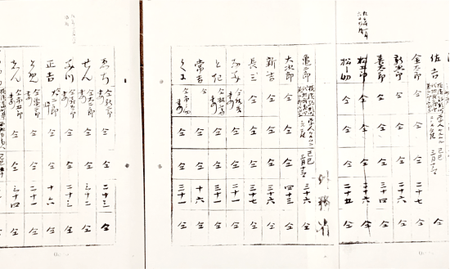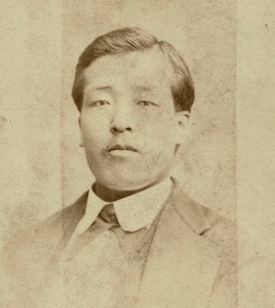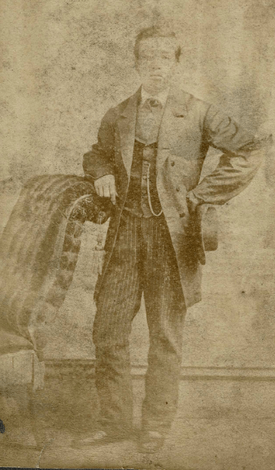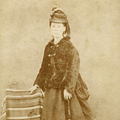According to Sakichi Yanagisawa’s family koseki, he was born on July 13, 1848. His domicile was Sakamoto Town, Usui County, Gunma Prefecture. He was probably at Wakamatsu Colony from the age of 20 to 21.
In A History of Yokohama City, he is listed as the son of Iseya Cyozo of Minami Shinagawa.
A Nichibei Shinbun article, published June 24, 1934, includes an interview with Yone in which she tells how Sakichi joined Schnell’s group and went to California, and had a hard time living in El Dorado County, where Wakamatsu Colony was located.
After the collapse of the Wakamatsu Colony, he returned to Japan and worked for the Interior Ministry’s Laboratory for the Promotion of Agriculture in Shinjuku, Tokyo in 1875 and was involved in the trial production of canned peaches. He was hired because of his agricultural experience and knowledge in the U.S.
In a San Francisco Examiner story published July 13, 1902, Sakichi returned to Japan with American modern agricultural equipment to help Japanese farming.
Then, he came to the U.S. again to fulfill his dreams in California.
He was converted to Christianity at the Chinese Mission in San Francisco by Dr. Otis Gibson, who did missionary work with Chinese and Japanese people at that time and later was involved in the formation of the Gospel Society or Fukuin-kai, a Japanese Christian organization established in San Francisco.
Dr. Gibson was one of the few people to speak out against the Chinese Exclusion Act of 1882.
Sakichi participated in the activities of Fukuin-kai and served as its treasurer in 1882. Fukuin-kai had a dormitory and supported Japanese students in San Francisco.

“My father told me that Sakichi worked at a winery in California and also ran restaurants,” said Ayako Matsufuji, Sakichi’s great-granddaughter.
In Jogaku zasshi, a Japanese women’s magazine, Sakichi said that he spent three years at the Fountain Grove vineyard in Santa Rosa, Sonoma County, where Kanae Nagasawa, who was known as California’s “Wine King,” worked. It seems that many Japanese were working there at that time.
In 1892, Sakichi opened a Western restaurant in Oakland. He is known as the first Japanese to open a restaurant in Oakland and later opened a restaurant in San Francisco.
Other Colony Members
In addition to Sakichi, the most frequently mentioned settlers of the Wakamatsu Colony are Okei, Matsunosuke Sakurai, Kuninosuke Masumizu, and Matsugoro Oto.
A History of Yokohama City contains a list of 23 Japanese who are believed to have been part of the Wakamatsu Colony.
They included not only Sakichi and his wife Nami, but also Rinsai and his wife Toki, Kintaro, Shinjiro and his wife Echi, all from present-day Chiba Prefecture; Kitaro and his wife Mitsu (from present-day Fukushima Prefecture); Ichinosuke (son of a merchant from Kitashinagawa, Tokyo) and his wife Kuki; Matsugoro (from Chiba); Matsunosuke (agricultural worker from Chiba); Kamejiro (worker from Asakusa, Tokyo) and his wife Tome; Daijiro (from Tokyo), his wife Sen and his son Masakichi; Shinkichi, Cyozo (a worker), and Tsunekichi (son of a merchant), all from Minami Shinagawa, Tokyo; Ichigoro and his wife Shin (from Chiba).
Twenty out of these 23 are matched to the names of 20 travelers identified as the Wakamatsu colonists in a March 13, 1869 document provided by the Diplomatic Archives, which is a record of the issuance of passports.

The name of Matsunosuke is also on the list, but is described as an “agricultural worker in Chiba Prefecture,” so it is unclear whether he is the same person as Matsunosuke Sakurai, who is said to have been a former samurai of the Aizu clan. There is no surname on the list.
On the other hand, Matsugoro’s place of residence matches with Matsugoro Oto’s family register.
According to A History of Yokohama City, a Prussian man named Kremer, who worked with Schnell in a Yokohama foreign settlement at that time, was supposed to take 23 people, 15 men and 8 women, to the U.S. and a man named Kenjiro of Komagata-cho was the mediator for the people. The reward was 50 ryo per man.
However, on April 22. 1869, Kenjiro filed a lawsuit against Kremer, claiming that Kremer had not paid for the food they were to receive.
Eventually, by June 17, 1870, 185 ryo were paid to Kenjiro and the matter was settled.
In the meantime, records show that three men and three women out of 23 people went to the U.S. and then 14 out of the remaining 17 departed on the steamship SS Japan on Aug. 24, 1869.
The unknown settlers who once crossed the ocean are still in their eternal rest somewhere in California or Japan.
In a time when there was no Internet, these settlers crossed over to a foreign country where they didn’t know the language.
On the other hand, nowadays, descendants who are interested in their ancestors, like Sakichi’s great-great-granddaughter Kanako Yamaguchi, can research their ancestors.
In this way, one by one, the pioneers who were lost in history are coming to light.
*This article was originally published in the Rafu Shimpo on January 8, 2022.
© 2022 Junko Yoshida / Rafu Shimpo







